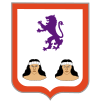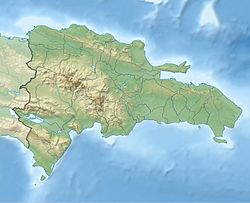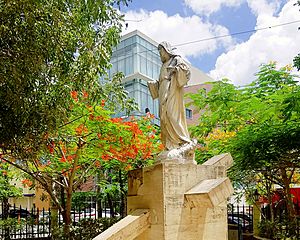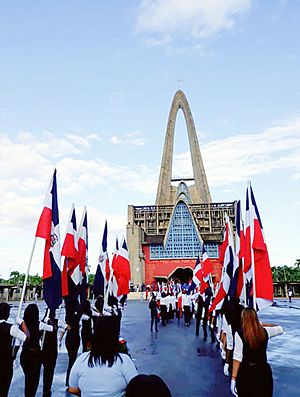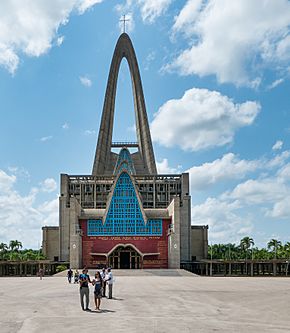Higüey facts for kids
Quick facts for kids
Higüey
|
||
|---|---|---|
| Salvaleón de Higüey | ||

Shrine of Our Lady of Altagracia in Higüey
|
||
|
||
| Country | Dominican Republic | |
| Province | La Altagracia | |
| Founded | 1503 | |
| Municipality since | 1844 | |
| Area | ||
| • Total | 2,029.14 km2 (783.46 sq mi) | |
| Elevation | 106 m (348 ft) | |
| Population
(2022)
|
||
| • Total | 415,084 | |
| • Density | 204.5615/km2 (529.8120/sq mi) | |
| • Demonym | Higüeyano(a) | |
| Municipal Districts | 3 | |
| Classification | Af | |
Higüey, also known as Salvaleón de Higüey, is an important city in the Dominican Republic. It is the capital of the eastern La Altagracia Province. In 2022, about 415,084 people lived there. The Yuma River flows through the city.
Higüey is one of the fastest-growing cities in the country. It is sometimes called the "Capital of Dominican Tourism." This is because many people who live here work in the big hotels of Punta Cana. Others sell things to tourists. The city is also known for its farming and raising animals.
Two very important buildings in Higüey are the Basilica of La Altagracia and the old Church of San Dionisio. The Church of San Dionisio was built in the 1500s.
Contents
- What Does the Name Higüey Mean?
- Higüey's Economy: How People Make a Living
- Visiting Higüey: Top Tourist Spots
- A Look at Higüey's History
- Parts of Higüey: City Sectors
- Higüey's Climate: Weather All Year Round
- The Basilica and Sanctuary of La Altagracia
- Punta Cana International Airport
- Popular Tourist Destinations
- Images for kids
- See also
What Does the Name Higüey Mean?
Some people believe the name Higüey comes from the native Taíno language. In their language, "GUEY" or "HUIOU" meant "sun."
Higüey is located on the eastern side of the island. This means it is one of the first places to see the sunrise. So, the name Higüey might mean "land where the sun is born."
Higüey's Economy: How People Make a Living
The economy of Higüey depends on several things. A lot of people work in tropical agriculture. They grow crops like coffee, tobacco, rice, and corn.
Raising animals like cattle and pigs is also important. Fishing is another way people make money, especially along the coast. Tourism is a huge part of the economy, with many jobs linked to the nearby resorts.
Visiting Higüey: Top Tourist Spots
The main attraction in Higüey is the Basilica of La Altagracia. This large church holds a special painting called the "Virgen de la Altagracia." Spanish missionaries brought this painting to the island in the 1400s.
Before the Basilica, the painting was kept in the 500-year-old Church of San Dionisio. Every year on January 21, which is a national holiday, thousands of pilgrims visit the Basilica. They come to honor the painting.
A Look at Higüey's History
When Europeans first arrived on the island of Hispaniola, the eastern part was home to the Taíno people. This area was led by chiefs like Cotubanamá and Cayacoa, and a female chief named Higuanamá. This region was the last part of the island to be taken over by the Spanish.
In 1503, a Spanish leader named Juan de Esquivel led the conquest of the area. This happened after a Taíno attack on Spanish sailors. The Spanish governor, Nicolás de Ovando, sent Esquivel to take control.
There were two wars in Higüey. The first was in 1502, and the second in 1504. Bartolomé de las Casas, a Spanish priest, wrote about the terrible events that happened there. Many native people were killed even after they surrendered.
These reports made people in Spain upset. The Spanish king and queen tried to make rules to protect the native people. These rules were called the Laws of Burgos in 1512. However, by 1519, most of the Taíno people in Higüey were already enslaved. Their numbers had dropped a lot. The Spanish then brought enslaved people from Africa to work.
In 1508, Higüey was given the right to have its own Coat of Arms. This gave it some local self-government. For a long time, Higüey was a part of El Seibo county.
Later, in 1801, a leader named Toussaint Louverture briefly took control of the Spanish part of Hispaniola. Spain had given this land to France in 1795. Spain got control back in 1809. During these changes, Higüey was a district of the Ozama department.
In 1822, Haitian forces took control of Higüey. This period was called the Haitian occupation of Santo Domingo. During this time, slavery ended in the area.
When the Dominican Republic became an independent country in 1844, Higüey became part of the Province of El Seibo. The country faced more challenges, including occupations by the United States in the 1900s.
Parts of Higüey: City Sectors
The city of Higüey is divided into more than 50 smaller areas called sectors. Some of these include:
- Alta Torre
- Antonio Guzmán
- Baja Torre
- Bávaro
- Cambelén
- Enriquillo
- Juan Pablo Duarte
- La Florida
- La Malena
- La Otra Banda
- Lagunas de Nisibón
- Los Guaricanos
- Los Platanitos
- Los Sotos
- Macao
- Mamá Tingó
- Naciado Mejía
- Pepe Rosario
- Sajour
- San Francisco
- San José
- San Martín
- Savica
- Los Rosales
- Verón-Punta Cana
- Villa Cerro
- Villa Higüey
- Villa Nazaret
Higüey's Climate: Weather All Year Round
Higüey has a tropical rainforest climate. This means it has warm temperatures all year. It also gets a lot of rain throughout the year.
Even though some months are drier, Higüey does not have a true dry season. The city gets more than 55 inches (1,400 mm) of rain every year.
| Climate data for Higüey, Dominican Republic (1961-1990) | |||||||||||||
|---|---|---|---|---|---|---|---|---|---|---|---|---|---|
| Month | Jan | Feb | Mar | Apr | May | Jun | Jul | Aug | Sep | Oct | Nov | Dec | Year |
| Record high °C (°F) | 35.0 (95.0) |
36.0 (96.8) |
37.0 (98.6) |
36.0 (96.8) |
37.0 (98.6) |
37.4 (99.3) |
37.0 (98.6) |
38.0 (100.4) |
38.4 (101.1) |
38.0 (100.4) |
39.0 (102.2) |
33.0 (91.4) |
39.0 (102.2) |
| Mean daily maximum °C (°F) | 29.1 (84.4) |
29.3 (84.7) |
30.2 (86.4) |
30.7 (87.3) |
31.2 (88.2) |
32.2 (90.0) |
32.4 (90.3) |
32.4 (90.3) |
32.5 (90.5) |
32.0 (89.6) |
30.7 (87.3) |
29.1 (84.4) |
31.0 (87.8) |
| Mean daily minimum °C (°F) | 20.0 (68.0) |
19.9 (67.8) |
20.3 (68.5) |
21.1 (70.0) |
22.1 (71.8) |
23.0 (73.4) |
23.3 (73.9) |
23.3 (73.9) |
23.0 (73.4) |
22.4 (72.3) |
21.6 (70.9) |
20.7 (69.3) |
21.7 (71.1) |
| Record low °C (°F) | 13.0 (55.4) |
14.5 (58.1) |
15.0 (59.0) |
16.1 (61.0) |
17.3 (63.1) |
19.0 (66.2) |
19.0 (66.2) |
19.1 (66.4) |
19.1 (66.4) |
19.1 (66.4) |
16.2 (61.2) |
16.8 (62.2) |
13.0 (55.4) |
| Average rainfall mm (inches) | 75.6 (2.98) |
66.8 (2.63) |
71.6 (2.82) |
105.3 (4.15) |
183.1 (7.21) |
101.3 (3.99) |
117.9 (4.64) |
141.2 (5.56) |
134.4 (5.29) |
160.0 (6.30) |
152.1 (5.99) |
113.9 (4.48) |
1,423.2 (56.04) |
| Average rainy days (≥ 1.0 mm) | 10.1 | 7.6 | 7.1 | 8.0 | 11.4 | 8.8 | 11.0 | 12.1 | 10.3 | 12.2 | 12.5 | 12.9 | 124 |
| Source: NOAA | |||||||||||||
The Basilica and Sanctuary of La Altagracia
The patroness of Higüey is the Virgin of La Altagracia. Her image is a painting brought to the island by Spanish missionaries. It is now displayed in the Sanctuary of Our Lady of La Altagracia.
Every year on January 21, thousands of Dominicans come to see this special image. This place might be the oldest shrine to the Virgin Mary in the Americas. The current Basilica was built to honor the painting. It is connected by a walkway to the older church.
The historic village of Salvaleón of Higüey was founded in 1505. It included a parish church. This church became the first Marian sanctuary in America.
The older brick cathedral was started in the mid-1500s. It has strong walls and a vaulted ceiling with five arches. The main altar area is shaped like a seashell. At the center of the altar, the old holy painting is shown in a silver frame. This frame was carved by hand from local wood in the 1500s.
The old cathedral has a simple outside. Its bell tower received bells in 1864. The floor was paved with marble a few years later.
The Sanctuary holds many special gifts from people. Some are very old and valuable. In 1922, for a special celebration, people donated a beautiful crown made of gold and jewels for the painting. The painting itself has a gold and silver frame with precious stones. The cathedral also has other valuable items like old silver cups and candlesticks.
Punta Cana International Airport
Punta Cana International Airport (IATA: PUJ, ICAO: MDPC) is a private airport in eastern Dominican Republic. It is built in a traditional Dominican style, with open-air buildings and roofs made of palm leaves. Many airlines fly to Punta Cana.
In 2002, over 1 million visitors used this airport, making it the busiest in the Dominican Republic. By 2007, it handled more than 3 million passengers. The airport plans to add another runway to handle even more visitors.
Popular Tourist Destinations
- Bávaro
- Punta Cana
- Bayahíbe
- Boca de Yuma
- El Parque Nacional del Este (East National Park)
- Basílica de Nuestra Señora de La Altagracia (Basilica of Our Lady of La Altagracia)
Images for kids
See also
 In Spanish: Higüey para niños
In Spanish: Higüey para niños


